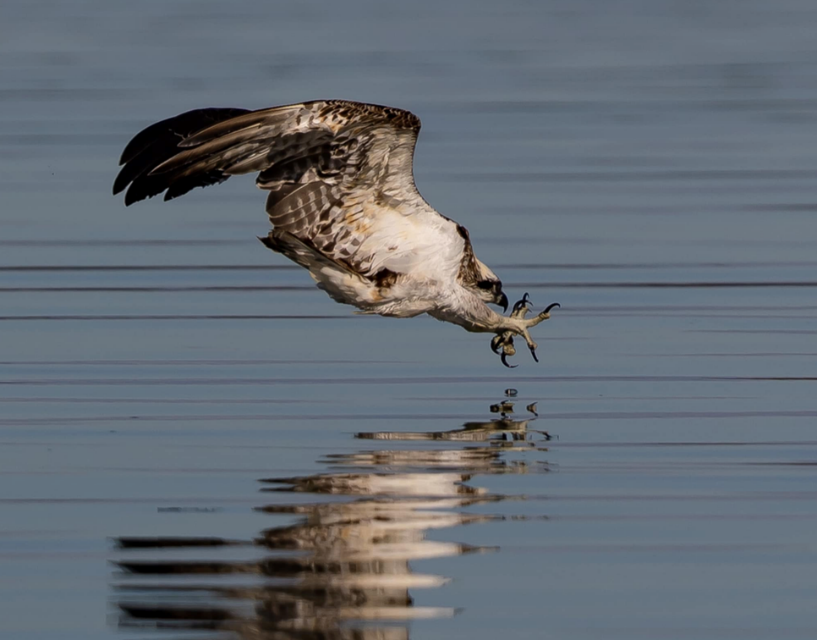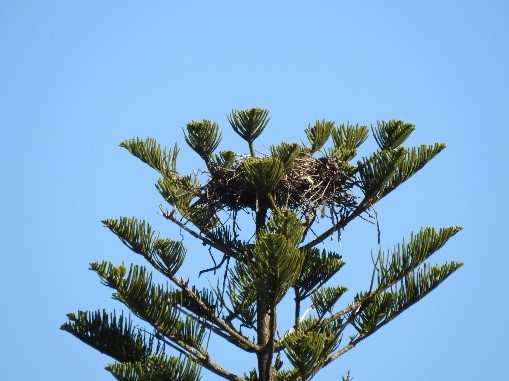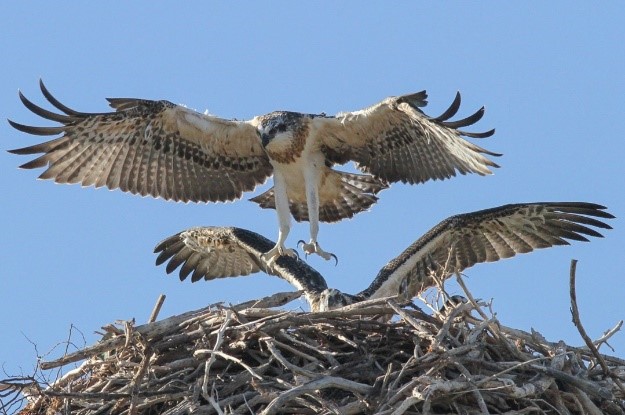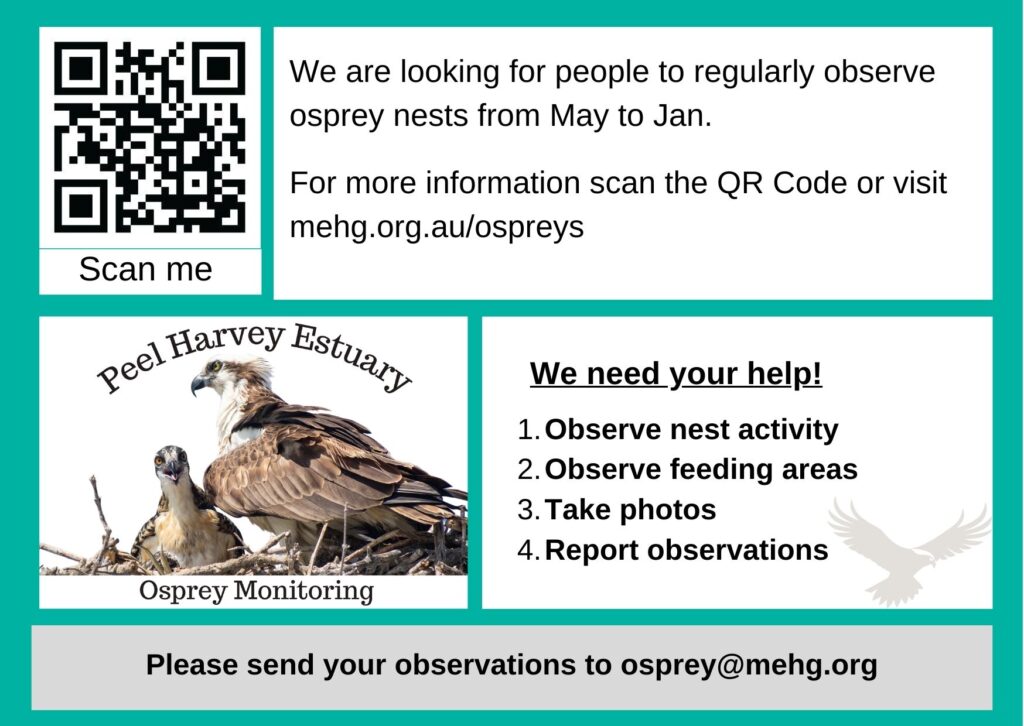NEW: Read the Osprey Breeding Census for the Peel Inlet and Harvey Estuary 2024 courtesy of Birdlife WA.
The Osprey Monitoring Program started in January 2024 by Lisa Wray in conjunction with MEHG to collate years of historical data and knowledge about the local population of eastern ospreys (Pandion haliaetus cristatus) that call the Peel-Harvey Estuary their home.
Ospreys are a majestic bird that grace our waterways and inlets as they fly overhead in search of fish. Ospreys execute a spectacular plunge to catch their prey with wings folded back and their legs extended forwards.


They will partly submerge and rise out of the water with a large fish.
Ospreys build their nests close to water, in an elevated position and this can even be in a tree in someone’s front yard, an artificial nesting platform, mobile phone tower or other tall structure.

One osprey nest can be found on top of the Telstra mobile phone tower on the corner of Pinjarra Road and Forrest Street in Mandurah.



The breeding season starts in May/June when nest repairs are undertaken, and pair bonds are strengthened. Incubation during August and September takes about 36 days and chicks are usually first seen in early October and leave the nest around Christmas time.


Mandurah Environment and Heritage Group is working in close conjunction with the City of Mandurah and Department of Biodiversity, Conservation and Attractions (DBCA) to census how many ospreys are breeding around the Peel-Harvey estuary and along the Serpentine, Murray and Harvey rivers.


Ospreys are an indicator species on the health of the Peel-Harvey Inlet, fish stocks and surrounding habitats. A register of the number of breeding pairs will allow us to monitor future trends.
The Peel-Harvey Inlet has the largest osprey population in the south-west of Western Australia. We have surveyed around the Peel Harvey estuary and have located about 40 osprey nesting sites, but many of these are no longer active or have fallen into disrepair.
Ospreys also breed along the Serpentine and Murray rivers. This season we hope to get a better understanding of the distribution of osprey breeding sites around the inlet and we are looking for volunteers who will adopt a nesting site and report on the progress and outcome of its breeding pair.
We are confident that with your help we will be able to find out how many active nests we have and how many osprey chicks are raised.
There are still many nest sites to be discovered, and we are keen to hear about these. Some residents might have historical information about a nesting site that they have been monitoring for many years, even decades.
This information is very valuable in clarifying the past distribution of ospreys. Some sites can only be surveyed by boat. At present the eastern side of the inlet is poorly surveyed, as is the region around the Harvey River.
Ospreys must contend with an increasing number of boats churning up the water, removal of large nesting trees due to housing developments and discarded fishing lines with hooks.

Storms cause nests to collapse, heatwaves cause mortality among chicks, and Australian ravens continuously harass ospreys


The “Adopt an Osprey Nest” program is a community science initiative that utilises interested volunteers to monitor osprey nests and track the reproductive success of nesting pairs throughout the Peel-Harvey estuary and rivers.
Surveying the reproductive success of osprey nesting pairs gives us valuable insights into the current distribution and health of populations. Data from these surveys is used to aid their conservation efforts.
We are looking for people of all ages to regularly observe osprey nests from May to January, and we need your help!
Observe nest activity
Observe feeding areas
Take photos
Report observations


During the breeding season you will see these common behaviours for each month:
May – June: Site preparation. Gathering new nesting materials and repairing and renovating nest
July – August: Sitting around the edge of the nest, mating.
September – October: Incubating nest will look quiet with the male coming to feed the female and often swapping over incubating duties.
October – November: Both parents feeding chicks and chicks will be very small, often not seen yet.
December – January: Chicks are bigger and can be seen from the nest, and stretching their wings. Watch them take their first flights!
View the map with the osprey nest locations and some historical data.
Some are located on private property. Please respect this and only observe from the road.
If you are a landowner with an osprey nest in your back or front yard, please could you send in observations regularly to osprey@mehg.org
Read the Volunteers Wanted for the Mandurah Osprey Census article featured in the Bushland News, courtesy of DBCA.
Read our article in the Autumn Issue of DBCA’s Bushland News: Ospreys in the Peel-Harvey Estuary: Insights from the 2024 breeding season
Here is a summary of the project so far which was presented at the AGM on 21st November 2024.
For more information please contact Lisa Wray on 0417 560 274 or email osprey@mehg.org
Thank you for helping to preserve this protected species.
Postcards for the Local Community








